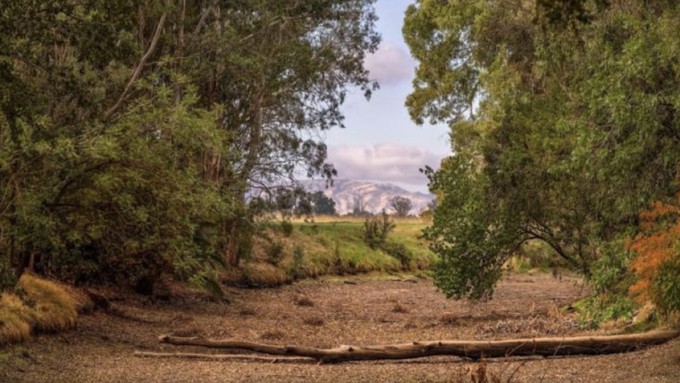
CNPS Ambassador Patricia Carpenter opens her property to visitors Sunday

Autumn softens all the colors in the landscape. This view looks west from Patricia Carpenter's garden, which is just outside Davis. Photo by Beth Savidge, courtesy Patricia Carpenter
With plants heading into dormancy and the colors softening, autumn is an ideal time to take an observational stroll through nature.
Patricia Carpenter, a California Native Plant Society Garden Ambassador, will open her 1-acre native-plant garden from 9 a.m. to 1 p.m. Sunday, Nov. 5, for her Autumn Ramble. (Remember that Pacific Standard Time starts early Sunday; clocks turn back 1 hour.)
The garden, west of Pierce Ranch Road south of Russell Boulevard, will be open rain or shine for self-guided tours; visitors may start any time during those hours. Admission is free but registration is required here. Maps will be available for use on site.
Carpenter's Verge Experiment, along the bike path that parallels Russell, recently was honored by Pacific Horticulture magazine. It was one of three West Coast gardens described by the publication as "volunteer-powered designs with community at their heart."
“After 35 years controlling weeds along the bike path in front of my property, I decided to start planting," she wrote in her application. "With climate change and the reality of recurring future droughts, I kept wondering just how little water I could use and the verge experiment began.”
The bike path is viewable any time, but Carpenter's property is open to the public just four or five times a year. On Sunday, an optional short orientation and Q&A gathering with Carpenter is scheduled at 10 a.m. and noon; meet at the check-in table. Other special activities for this Ramble:
-- Botanist Glen Holstein will be in attendance. His favorite topics include the new CNPS Yolo-Colusa Chapter and conservation of native plants.
-- Restoration ecologist Julia Michaels from Hedgerow Farms will visit to give away native wildflower seeds and show off some of the cool species growing at Hedgerow. https://hedgerowfarms.com/
-- The Miridae Mobile Nursery will parked next to the property to satisfy visitors' native-plant purchase urges. A link to their current plant list is available here.
Visitors are advised to wear sturdy shoes, and are welcome to bring a lunch or snack to enjoy onsite. No dogs, please. A composting toilet available.
Carpenter's non-native garden will be open to view as well. Read more about her native garden on her CNPS profile page.
Comments
0 comments have been posted.Sacramento Digs Gardening to your inbox.
Food in My Back Yard Series
May 6: Maintain soil moisture with mulch for garden success
April 29: What's (already) wrong with my tomato plants?
April 22: Should you stock up on fertilizer? (Yes!)
April 15: Grow culinary herbs in containers
April 8: When to plant summer vegetables
April 1: Don't be fooled by these garden myths
March 25: Fertilizer tips: How to 'feed' your vegetables for healthy growth
March 18: Time to give vegetable seedlings some more space
March 11: Ways to win the fight against weeds
March 4: Potatoes from the garden
Feb. 25: Plant a fruit tree now -- for later
Feb. 18: How to squeeze more food into less space
Feb. 11: When to plant? Consider staggering your transplants
Feb. 4: Starting in seed starting
Sites We Like
Garden Checklist for week of May 11
Make the most of the lower temperatures early in the week. We’ll be back in the 80s by Thursday.
* Plant, plant, plant! It’s prime planting season in the Sacramento area. Time to set out those tomato transplants along with peppers and eggplants. Pinch off any flowers on new transplants to make them concentrate on establishing roots instead of setting premature fruit.
* Direct-seed melons, cucumbers, summer squash, corn, radishes, pumpkins and annual herbs such as basil.
* Harvest cabbage, lettuce, peas and green onions.
* In the flower garden, direct-seed sunflowers, cosmos, salvia, zinnias, marigolds, celosia and asters. (You also can transplant seedlings for many of the same flowers.)
* Plant dahlia tubers.
* Transplant petunias, marigolds and perennial flowers such as astilbe, columbine, coneflowers, coreopsis, dahlias, rudbeckia and verbena.
* Keep an eye out for slugs, snails, earwigs and aphids that want to dine on tender new growth.
* Feed summer bloomers with a balanced fertilizer.
* For continued bloom, cut off spent flowers on roses as well as other flowering plants.
* Add mulch to the garden to maintain moisture. Mulch also cuts down on weeds. But don’t let it mound around the stems or trunks of trees or shrubs. Leave about a 6-inch-to-1-foot circle to avoid crown rot or other problems.
* Remember to weed! Pull those nasties before they set seed.
* Water early in the day and keep seedlings evenly moist.